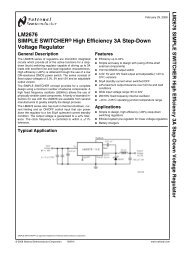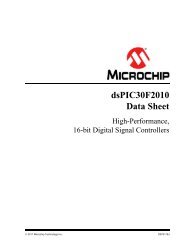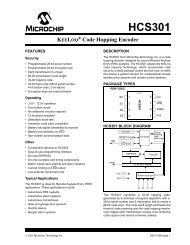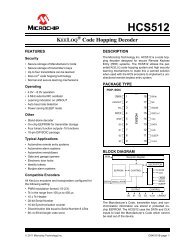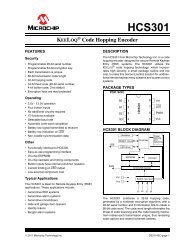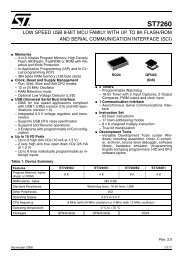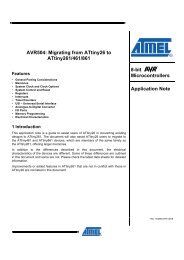Create successful ePaper yourself
Turn your PDF publications into a flip-book with our unique Google optimized e-Paper software.
General-purpose timers<br />
<strong>STM32W108C8</strong><br />
Table 86.<br />
Timer signal descriptions (continued)<br />
Signal Internal/external Description<br />
ICyPS<br />
ITR0<br />
OCy<br />
OCyREF<br />
PCLK<br />
Internal<br />
Internal<br />
External<br />
Internal<br />
External<br />
Input capture signal after filtering, edge detection and<br />
prescaling: input to the capture register.<br />
Internal trigger input: connected to the other timer's output,<br />
TRGO.<br />
Output compare: TIMxCy when used as an output. Same as<br />
OCyREF but includes possible polarity inversion.<br />
Output compare reference: always active high, but may be<br />
inverted to produce OCy.<br />
Peripheral clock connects to CK_INT and used to clock input<br />
filtering. Its frequency is 12MHz if using the 24MHz crystal<br />
oscillator and 6Mhz if using the 12MHz RC oscillator.<br />
TIy Internal Timer input: TIMxCy when used as a timer input.<br />
TIyFPy Internal Timer input after filtering and polarity selection.<br />
TIMxCy<br />
Internal<br />
Timer channel at a GPIO pin: can be a capture input (ICy) or<br />
a compare output (OCy).<br />
TIMxCLK External Clock input (if selected) to the external trigger signal (ETR).<br />
TIMxMSK<br />
External<br />
Clock mask (if enabled) AND'ed with the other timer's<br />
TIMxCLK signal.<br />
TRGI Internal Trigger input for slave mode controller.<br />
10.2 Interrupts<br />
Each timer has its own ARM® Cortex-M3 vectored interrupt with programmable priority.<br />
Writing 1 to the INT_TIMx bit in the INT_CFGSET register enables the TIMx interrupt, and<br />
writing 1 to the INT_TIMx bit in the INT_CFGCLR register disables it. Section 12: Interrupts<br />
on page 174 describes the interrupt system in detail.<br />
Several kinds of timer events can generate a timer interrupt, and each has a status flag in<br />
the INT_TIMxFLAG register to identify the reason(s) for the interrupt:<br />
● INT_TIMTIF - set by a rising edge on an external trigger, either edge in gated mode<br />
● INT_TIMCCRyIF -set by a channel y input capture or output compare event<br />
● INT_TIMUIF - set by an update event<br />
Clear bits in INT_TIMxFLAG by writing a 1 to their bit position. When a channel is in capture<br />
mode, reading the TIMx_CCRy register will also clear the INT_TIMCCRyIF bit.<br />
The INT_TIMxCFG register controls whether or not the INT_TIMxFLAG bits actually request<br />
an ARM® Cortex-M3 timer interrupt. Only the events whose bits are set to 1 in<br />
INT_TIMxCFG can do so.<br />
If an input capture or output compare event occurs and its INT_TIMMISSCCyIF is already<br />
set, the corresponding capture/compare missed flag is set in the INT_TMRxMISS register.<br />
Clear a bit in the INT_TMRxMISS register by writing a 1 to it.<br />
141/215 Doc ID 018587 Rev 2





